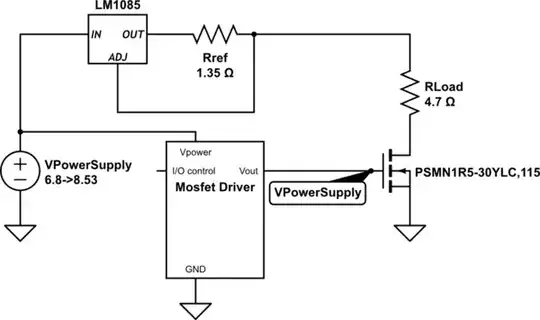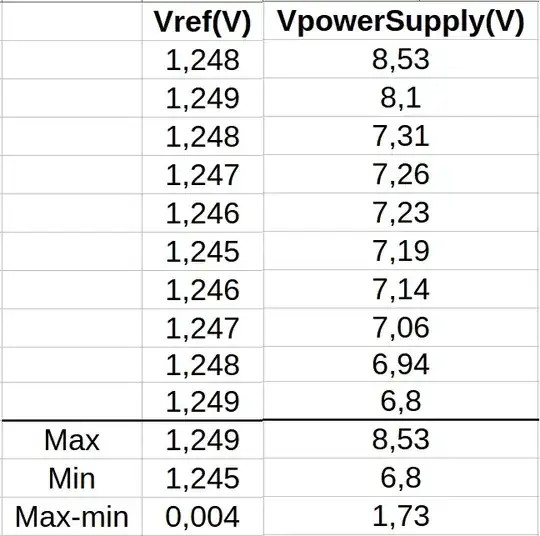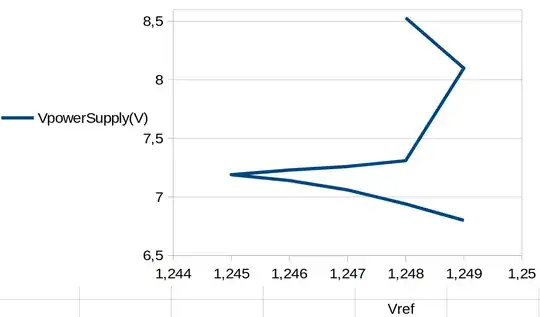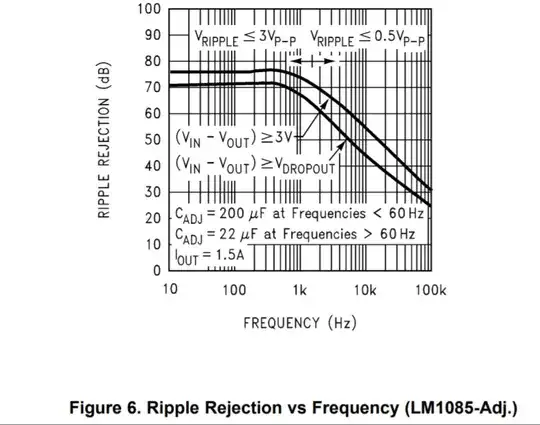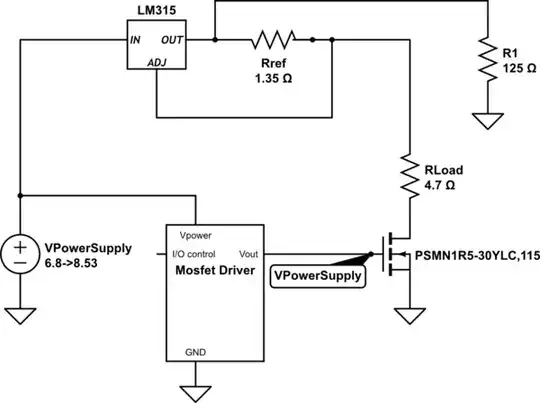To find the source of this fluctuation in \$V_{REF}\$, we first need to understand what currents are at work here.
On page 6 of that datasheet you'll find \$I_{ADJ}\$ and \$\Delta I_{ADJ}\$. These refer to the current being sourced by the ADJ pin of the regulator, and the low value of \$\Delta I_{ADJ}=0.2\mu A\$ suggests that \$I_{ADJ}\$ is fairly constant at 55μA, but may vary somewhat around this value.
Kirchhoff's Current Law (KCL) requires that this current combine with the current \$I_{OUT}\$ at the junction between \$R_{REF}\$ and \$R_{LOAD}\$, like this:
$$I_{LOAD} = I_{OUT} + I_{ADJ}$$
Rearranging that to find the current \$I_{OUT}\$ through \$R_{REF}\$:
$$I_{OUT} = I_{LOAD} - I_{ADJ}$$
Let's assume (incorrectly) that the regulator manages to keep \$I_{LOAD}\$ constant at the target value of 0.92A, and that consequently the voltage fluctuation you see across \$R_{REF}\$ (which is proportional to the fluctuation of current \$I_{OUT}\$) is due entirely to a variation in current \$I_{ADJ}\$.
The fluctuation in \$I_{OUT}\$ is:
$$ \Delta I_{OUT} = \frac{V_{REF\_MAX}}{R_{REF}} - \frac{V_{REF\_MIN}}{R_{REF}} = \frac{0.004V}{1.35\Omega} = 3mA $$
This is clearly far greater than \$\Delta I_{ADJ}=0.2\mu A\$, and the conclusion can only be that the majority of the variation you see in \$V_{REF}\$ has nothing to do with \$I_{ADJ}\$. In other words, this regulator is not regulating perfectly, and our earlier assumption that \$I_{LOAD}\$ is being pefectly maintained at 0.92A is wrong.
If \$I_{ADJ}\$ is truly constant at 55µA, changes in \$V_{REF}\$ must actually be due to imperfect regulation, and you would see a similar percentage error in \$I_{LOAD}\$. That error is about:
$$ \sigma = \frac{3mA}{0.92A} \approx 0.3\%$$
That's better than the datasheet's quoted load regulation of 1%, but is far from perfect, and illustrates why this particular characteristic of regulators is always included in the datasheets.
As to why this happens, there are many causes, but the big ones might be:
Finite output impedance, which is not constant, and is related to (but not necessarily proportional to) load current. This effectively appears in series with \$R_{REF}\$.
Imperfect internal voltage reference. The designer intended to mitigate this source of error by using a constant current source to drive his reference zener diode (hence the constant value of \$I_{ADJ} = 55\mu A\$) but that can't completely eliminate reference errors.
Non linearity in the reulator's error amplifier, which arises from things like input bias currents and offsets and finite gain, all typical problems you encounter in control systems using op-amps.
While I think your experiment is great, and everybody should be doing things like this, I don't really trust your graph, because there aren't enough data points. It looks quite chaotic, and the lack of a smooth curve here really puts into question your claim that there's a peak at \$V_{IN} = 7.19V\$.
If you made more measurements around that value, which resulted in a smooth(ish) curve around that point in the graph, I would have more confidence in the claim.
Also, I don't know the quality of your test equipment. If for example you are using a multimeter with 1% accuracy, you can't really trust the third digit. This is particularly important here, where changes in \$V_{REF}\$ are of the order of millivolts. When measuring a signal on the 2V range of your DVM, you would need accuracy of 0.05% or better to have any confidence in the 4th digit, which would represent millvolts.
